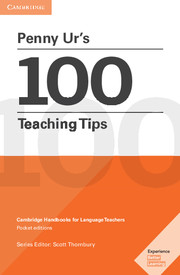Book contents
- Frontmatter
- Contents
- Why I Wrote this Book
- Beginning and Ending the Lesson
- The Coursebook
- Discipline
- Error Correction
- Games
- Grammar
- Group Work
- Heterogeneous (Mixed-Level) Classes
- Homework
- Interest
- Listening
- Pronunciation
- Reading Comprehension
- Speaking Activities
- Teacher Talk
- Testing and Assessment
- Vocabulary Teaching
- Writing
- P.S.
- Index
- Photo Acknowledgements
Heterogeneous (Mixed-Level) Classes
Published online by Cambridge University Press: 17 November 2023
- Frontmatter
- Contents
- Why I Wrote this Book
- Beginning and Ending the Lesson
- The Coursebook
- Discipline
- Error Correction
- Games
- Grammar
- Group Work
- Heterogeneous (Mixed-Level) Classes
- Homework
- Interest
- Listening
- Pronunciation
- Reading Comprehension
- Speaking Activities
- Teacher Talk
- Testing and Assessment
- Vocabulary Teaching
- Writing
- P.S.
- Index
- Photo Acknowledgements
Summary
A well-known half-joking definition of a heterogeneous class is ‘a class of two’: as soon as you have more than one student, you have heterogeneity. You always need to cope with different people among any student group. So these tips are applicable to virtually all classes.
38 Let students choose
39 Attend to the weaker students
40 Invite different answers
41 Limit tasks by time, not amount
42 Give basic tasks plus options
38 Let students choose
Whenever you can, allow students some choice in the items they want to answer in a language exercise, so they can opt for those that are closer to their level or interests.
Textbooks don't usually allow for student choice in exercises. They usually just give directions like Match … or Complete … . You can introduce an element of choice by using one of the following strategies:
• Start where you like. Read through (without answering) a set of question items, then tell students they can raise their hands to answer any of the items they like. So one student who wants to respond to a more challenging item that happens to be question 7, or another who wants to answer an easier one that is question 10 – can do so immediately. The same can be done if the students are writing down their answers.
• Do any six of the questions. (Or five, or three, or whatever.) This works best for written work. The principle is the same as the above. Make sure the exercise is understood by all the class, and then tell them to choose which questions they want to answer and which they don’t.
• Work cards. (My favourite, I must have done this one hundreds of times.) Compose or adapt from a textbook or website ten or fifteen brief ‘bite-sized’ tasks each of which will take only short time to do. Put each on a card or separate slip of paper; you’ll probably need two or three copies of each. Put these at a central point in the classroom, perhaps on your desk. Each student chooses a slip, writes his or her responses in a notebook, and then brings it back and chooses another. Make sure students know they aren't allowed to write on the original slips! If you think you’ll use the slips again, then paste them onto card and laminate them.
- Type
- Chapter
- Information
- Penny Ur's 100 Teaching TipsCambridge Handbooks for Language Teachers, pp. 45 - 50Publisher: Cambridge University PressPrint publication year: 2016



